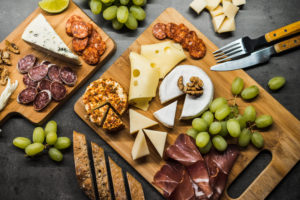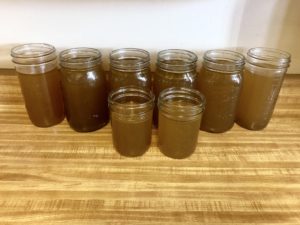Because the best health insurance is on your plate
The deeper down I go into this ever-changing world of health science and nutrition, the greater the need I see for basic knowledge of how our own bodies work and relate to food to be the norm.
Superficially speaking, eating “healthy” seems so simple that it gets promoted with slogans such as “you are what you eat,” “an apple a day keeps the doctor away,” “eat __ servings of fruits and veggies every day for optimal health,” … and so on. Most of us get the connection between eating healthy, being healthy, and our overall quality of life.
But if you look a bit deeper, you might begin wonder what constitutes for healthy in a culture as complex and polarizing as ours? Who’s body are we talking about when we give and receive health advice and why is one food “healthy” while another food unhealthy?
Most of us also hear terms like “junk food” and “health food” and can see clear distinctions between the two; a salad vs. McDonald’s, something processed vs. something whole. But what about when someone eats something with less clear distinctions from a health perspective — such as meat vs. soy or cooked food vs. raw? And why the fuck should it matter?
Here’s why it matters: because few of us eat a food just once. We’re all creatures of habit and we tend to choose the same foods day after day, year after year. This accumulated fuel (food) and repetitive consumption habits dictate how every cell in our body operates — thus altering who we are, inside and out. If we understand the basics of what our bodies need and cater our food choices to these basic needs, now we’ve got creative control over who we are, inside and out!

Obstacles To Health
I see some big modern obstacles to making smart nutrition a daily norm — especially for those of us seeking recovery from complex chronic illness, or even simply premature aging. We all want to feel and look our best while regaining the functions illness may have stolen from us. But these obstacles can keep us cycling through the same symptoms, year after year.
So before I dive into the nutrition basics everyone ought to know, I’d like to label these obstacles and offer basic solutions to make healthy choices from in spite of it all.
- Obstacle #1: We live in a culture (industrial civilization, that is) which endorses pseudo “foods” and lifestyle behaviors which are antithetical to healing and optimal gene expression. Therefore our appetites often don’t function properly and our environments are working against us on a micro and macro level each day.
- Obstacle #2: Access to whole, healthy foods is a class issue. Dirty Capitalism places profits over health and this impacts lower classes first and foremost, making it harder for economically challenged people to access healthy foods easily.
- Obstacle #3: We live in a time where science is being manipulated and influenced by religious dogma and by corporate incentives. This often leaves us either mistrusting all health rhetoric or being led astray by misleading articles and poorly reported studies.
- Obstacle #4: There are too many humans alive these days with so many different biochemical needs that we fall into assuming what works for someone else must work for us. But our bodies need individualized care, even amongst siblings.
- Obstacle #5: Our culture seriously lacks an evolutionary template or historical context to place our health challenges in. We aren’t taught to systems think, leaving it much harder to make educated health and diet decisions without a well-rounded reference point.
In response to these obstacles I created some action steps to take to set solid foundations for applying what I’m about to teach you.
- Solution #1: Consider the most crucial and initial step in applying nutrition basics to your life is EATING WHOLE FOODS. This includes both plants and animals and should exclude anything in a box with an ingredients list longer than a few items you can recognize. ONLY WHOLE FOODS.
- Solutions #2: Be very selective in who and where you receive nutrition and health information from. Consider that very little in science is as simple as A–>B and most studies in health and nutrition offer us correlative results, NOT CAUSATION. Keep in mind two things: 1) science journalists only get paid if articles get clicked on and shared and this happens through dramatic headlines and oversimplifications, and 2) much of our dietary recommendations were born out of industrial and religious propaganda and may not be true for you.
- Solution #3: Seek assistance if you need. Research which foods are OK to buy conventionally. Look at where you’re spending $ that could go towards your health. Remember, our genetic inheritance is JUST as important as a house or car. Prioritize healthy food and lifestyle choices above entertainment, material belongings, and distraction.
- Solution #4 Once you understand the basic essential nutrients all human bodies must get from food, you can start paying attention to which ones you may need more of than others. And it’s important to keep in mind that just as your fingerprints are totally unique, your biological needs are totally unique.
- Solution #5: Adopt an evolutionary lens to view your health and behavior. Start asking yourself questions which require that you learn about evolution and history to find answers. Keep a bigger picture and remember that we need more than modern epidemiology to understand what’s healthy. We need more than studies being done on modern humans and rats because most of what is modern didn’t exist a century ago and came to be through the function of many systems.
Why Some Nutrients Are Essential
Essential nutrients are called essential because we must get them from our food or supplementation; our bodies cannot produce them on their own. Once upon a time when our soil was fertile and free from pesticides and depletion, we were able to get more nutrients from soil-grown wild vegetables and animals and so we evolved with bodies that expect this. However, after thousands of years of tilling our soil, our modern use of pesticides, and our consumption of a few low-nutrient mono-crops, we’re no longer able to get the same amount of nutrients from the plants and animals we eat.
Therefore, modern humans must make an intentional effort to assure we’re getting these essential nutrients through good food sourcing, nutrient-dense choices, and supplementing when necessary. I also believe it’s important that we see clearly and understand our own religious and emotional biases towards certain foods over others and the ways this may be keeping us nutrient-deficient and sick.
Essential Minerals

Minerals play important roles in sooo many things! Maintaining blood pressure, fluid & electrolyte balance, and bone health, making new cells; delivering oxygen to cells, and contributing to normal muscle and nerve functioning. Minerals are widely distributed in foods, with specific minerals being found higher in certain foods. By eating a variety of nutrient-dense foods, we’re more likely to have a mineral-rich diet. I DON’T recommend eating foods synthetically fortified with Iron or calcium, as it is usually poorly absorbed, of questionable quality, and usually found in industrial foods I don’t recommend you eat anyway.
Two minerals of particular importance are calcium and iron. Unfortunately, many Americans do not consume enough iron or calcium — despite common beliefs about overconsumption of dairy and red meat, we’re actually eating less of those things than ever before. Calcium is needed for the formation of strong bones and teeth from birth through adulthood. Calcium is found in dairy – milk, cheese, and yogurt, mustard greens, kale, broccoli and select legumes. If you follow a paleo (ish) diet or just don’t do well with dairy, I recommend that you supplement with a good quality bone meal calcium supplement and consume bone-in sardines weekly, along with bone broth, and even consuming some of the softer bones from the poultry you eat.
Iron is part of hemoglobin in red blood cells and myoglobin in muscle cells. So iron helps to carry oxygen from the lungs to working cells throughout the body. Iron deficiency, the most common nutrient deficiency worldwide, results in fatigue, weakness, pallor (pale skin, lips, tongue, palms and mouth), and anemia. Iron is found mainly in meat, poultry, fish, eggs, legumes, greens, and dried fruits. If you eat a vitamin C source and an iron source at the same meal, you can double the amount of iron absorbed. Despite common belief amongst vegetarians, plant-based iron is clinically proven to be far inferior to the active form, heme iron, available in animal sources.
All of the minerals below are crucial and must be obtained through food. After researching each one of these minerals, I’ve come to see that most Americans are deficient in all of these. My recommendation is that you try to add in one of the foods listed next to the nutrient each day to ensure that you have enough. I highlighted the macrominerals (which we need in larger quantities) in red and the trace minerals (which we need only traces of) in black.
- calcium – all dairy products, digestible bones, bone broth, broccoli, kale, hulled sesame seeds, coconut milk
- phosphorus – dairy products, fish, muscle meat, organ meats, nuts and seeds, legumes
- potassium – beet greens, avocados, bananas, potatoes, sweet potatoes, yams, coconut water, pomegranate, spinach, squash
- sulfur – pastured animal muscle and organ meat, pastured eggs, and smaller amounts from cruciferous vegetables, garlic, onions
- sodium – sea salt added to food, bone broth, seafood, sea vegetables, beets, celery,
- chloride – kelp (seaweed), ionic trace minerals, olives, tomatoes, lettuce, and celery,
- magnesium – dark chocolate/cacao, almonds, leafy greens, pumpkin seeds, high-quality yogurt
- iron – clams, oysters, liver, other organ meats, grassfed beef, lamb, poultry, leafy greens, cocoa, sunflower seeds (less bioavailable)
- zinc – liver, oysters and clams, egg yolks, dairy, muscle meat, nuts/seeds/legumes in smaller less bioavailable amounts
- copper – liver, oysters, shiitake mushrooms, greens, dark cocoa/cacao, spirulina
- manganese – clams, oysters, toasted wheat germ, firm tofu, sweet potatoes, pine nuts, lima beans, chickpeas
- iodine – sea food, sea vegetables (kelp and dulse in particular), iodine salt
- selenium – Brazil nuts, wild salmon, liver, tuna, and halibut, beef, sunflower seeds,
- chromium – broccoli, grapes, grass-fed beef, turkey, potatoes, green beans, apples,
- fluoride – celery, white rice, white potatoes, spinach, asparagus, carrots
Essential Vitamins

Vitamins play many crucial roles in our body, such as maintaining healthy eyes, hair, skin, and all basic internal organ functions. They act as antioxidants to protect our cells from damage and to encourage cell turnover, they contribute to healthy reproduction & fertility, to strong bones and normal blood clotting, and to efficient detoxification. They play critical roles in ensuring that our methylation processes work and proper enzymes get produced, and so much more. Different vitamins are found in foods from both plants and animals and by eating a variety of nutrient-dense ancestral foods, you’ll have a vitamin-rich diet.
- Vitamin A – liver, egg yolks, fatty fish, cod liver oil, and precursors found in greens, orange, and yellow vegetables (needs conversion)
- Vitamin C – most heat sensitive vitamin, found highest in citrus, sweet peppers, leafy greens
- Vitamin D – D3 is activated through sunlight, but D2 can be obtained from fatty fish, liver, pastured eggs, dairy, and muscle meat
- Vitamin E – almonds, sunflower seeds, avocados, leafy greens
- K1 – leafy greens, broccoli, brussel sprouts, cabbage, onions
- K2 – liver, grassfed dairy, butter, ghee, pastured animal muscle meat
- and 8 B vitamins:
- thiamin (B1) – nutritional yeast, legumes
riboflavin (B2) – liver, kidney, heart, almonds
niacin (B3) – nutritional yeast, liver, legumes
pantothenic acid (B5) – nutritional yeast, liver, roasted sunflower seeds
pyridoxine/pyridoxane (B6) – nutritional yeast, liver, muscle meat, seeds
biotin (B7) – liver, egg yolks, muscle meat
folate (called folic acid when included in supplements) (B9) – liver, chickpeas, black/kidney/pinto beans
vitamin B12 (cyanocobalamin) – liver, clams, oysters, clams, nori, muscle meat, wild-caught fish
Essential Amino Acids

Amino acids contribute to the development of protein within the body and are vital in promoting wound repair and encouraging healthy tissue in muscles, bones, skin and hair. Amino acids are also crucial in eliminating waste deposits related to metabolism. Out of the 22 amino acids, there are nine essential amino acids: Isoleucine, Leucine, Lysine, Methionine, Phenylalanine, Threonine, Tryptophan, Valine, and Histidine.
Foods containing all nine of these amino acids are called complete proteins. These complete proteins are essential to our overall health, which is why they are comprised of the essential amino acids. Our bodies need all nine of these essential amino acids for basic health; since our bodies cannot make them naturally, we must get them from other sources, such as food and supplements. The best sources of essential amino acids are animal proteins like meat, eggs and poultry.
- histidine – Used to produce histamine, a neurotransmitter that is vital to immune response, digestion, sexual function and sleep-wake cycles. It’s critical for maintaining the myelin sheath, a protective barrier that surrounds your nerve cells
- isoleucine – The last of the three branched-chain amino acids, isoleucine is involved in muscle metabolism and is heavily concentrated in muscle tissue. It’s also important for immune function, hemoglobin production and energy regulation
- leucine – Like valine, leucine is a branched-chain amino acid that is critical for protein synthesis and muscle repair. It also helps regulate blood sugar levels, stimulates wound healing and produces growth hormones
- lysine – Plays major roles in protein synthesis, hormone and enzyme production and the absorption of calcium. It’s also important for energy production, immune function and the production of collagen and elastin
- methionine – Plays an important role in metabolism and detoxification. It’s also necessary for tissue growth and the absorption of zinc and selenium, minerals that are vital to your health
- phenylalanine – A precursor for the neurotransmitters tyrosine, dopamine, epinephrine and norepinephrine. It plays an integral role in the structure and function of proteins and enzymes and the production of other amino acids
- threonine – A principal part of structural proteins such as collagen and elastin, which are important components of the skin and connective tissue. It also plays a role in fat metabolism and immune function
- tryptophan – Needed to maintain proper nitrogen balance and is a precursor to serotonin, a neurotransmitter that regulates your appetite, sleep and mood
- valine – One of three branched-chain amino acids, meaning it has a chain branching off to one side of its molecular structure. Valine helps stimulate muscle growth and regeneration and is involved in energy production
Essential Fats

Fats, including saturated fatty acids, play important roles in the body. These essential fatty acids (EFAs) are based on linoleic acid (omega-6 group) and alpha-linolenic acid (omega-3 group). We need both groups of essential fatty acids to survive. Due to the modern industrial diet of grain and seed oils, there’s a disproportionate intake of omega-6 fatty acids over omega-3 fatty acids, which is correlated with a greater chance of chronic inflammation and all kinds of health .
So it’s important to eat the right foods to make sure that you’re taking in enough and the right kinds of the essential fatty acids. However, there is much more to the story. Studies have shown that increasing the intake of certain essential fatty acids, either alone or in combination with other fats and compounds, can increase health, help in treating certain diseases, and even improve body composition, mental and physical performance. Due to the already high amounts of omega-6 in our diets, I’m going to assume you don’t need to know more about where to source those; they’re in everything processed and grain-heavy. Instead, I will list out the three most important omega-3 EFA which I believe we could all use more of!
- ALA (Alpha-Linolenic Acid) – This is the most common omega-3 fatty acid in the diet. ALA is mostly found in plant foods, and needs to be converted into the EPA or DHA before it can be utilized by the human body & this conversion process is inefficient in humans. Only a small percentage of ALA is converted into EPA, and even less into DHA. Another reason why I don’t recommend a vegan diet for any length of time. It’s found in many plant foods, including kale, spinach, purslane, soybeans, walnuts and many seeds such as chia, flax and hemp seeds.
- EPA (Eicosapentaenoic Acid) – Its main function is to form signaling molecules called eicosanoids, which play numerous physiological roles. Eicosanoids made from omega-3s reduce inflammation, while those made from omega-6s tend to increase inflammation. For this reason, a diet high in EPA may reduce inflammation in the body and chronic, low-level inflammation is known to drive several common diseases. Several studies have shown that fish oil, which is high in EPA and DHA, may reduce symptoms of depression. Both EPA and DHA are mostly found in seafood, including fatty fish and algae. For this reason, they are often called marine omega-3s.
- DHA (Docosahexaenoic Acid) – It’s an important structural component of skin and the retina in the eye and fortifying baby formula with DHA has been clinically proven to improve vision in formula-fed infants. It’s absolutely vital for brain development and function in childhood, as well as brain function in adults. Early-life DHA deficiency is associated with problems later on, such as learning disabilities, ADHD, aggressive hostility and several other disorders. A decrease in DHA during aging is also associated with impaired brain function and the onset of Alzheimer’s disease, greater risk of heart disease, and could contribute to type 2 Diabetes and autoimmunity. It’s found in high amounts in seafood, including fatty fish and algae, and grass-fed animal products.
Why Nutrient Bio-availability is so Crucial
Above I outlined all of the best food-sources of nutrients in each category and below I’ve simplified it even more with another list to give you the biggest bangs for your nutrient buck. These are the real Super Foods of the plant and animal kingdom; eaten daily, you’ll be doing more for your health than any pill, juice cleanse, or fad diet could ever do for you.
But first I want to let you in on a crucial aspect to smart nutrition, called nutrient bio-availability.
Bio-availability refers to how much nutrients our human bodies can extract from any given food. Although this varies from person to person depending on gut health, lifestyle stressors, genetics, etc… there are some core reasons why nutrients in foods may not be well-absorbed by people who are aiming to eat healthy.

Some of these reasons involve chemicals we call enzyme inhibitors (these inhibit our bodies’ ability to create the necessary enzymes for breaking down nutrients) and some we call anti-nutrients (these bind to nutrients, altering or eliminating their ability to make it into our cells). These chemicals can be very very problematic for those with damaged guts, autoimmunity, and other chronic health problems. They can also just be an energy drain for everyone else in otherwise decent health.
Identifying and eliminating some main sources of these disruptive chemicals (we cannot remove all of them — they’re in everything!) is what has made all the various versions of the controversial “paleo” movement so successful for so many. This is due to the fact that some of the most harmful of these chemicals live in grains and industrial foods like sugar and vegetable oil. Especially within the autoimmune paleo practice, removing many core sources of these chemicals often reduces and sometimes eliminates entirely, symptoms of autoimmunity.
This involves personalized experimentation with removing a whole host of immunogenic foods and isn’t recommended unless your symptoms are so disruptive that it’s a beneficial trade-off to be this restrictive. For everyone else merely seeking to optimize your health and feel better, knowing which foods might deplete your nutrients and consuming less of these could be a good habit to get into. To give my readers a better idea, here are a few of the main chemicals found in foods which can disrupt our nutrient absorption:
- Phytates
- Lectins
- Goitrogens
- Oxalates
- Saponins
- FODMAPS
The paradoxical truth about these compounds is that they actually act as antioxidants in the human body, providing healthy micro-stressors (hedonic stressors) which can ultimately strengthen our immune systems in low doses. The problem is that so many of us in modern life are both immunocompromised and also nutrient deficient — having been raised on industrially processed nutrient-deficient foods. Therefore, getting these hedonic stressors in mass amounts in each meal has done faaaar more harm than good. This is why I’m not implying we should stop eating all vegetables, grains, or legumes, but to put the breaks on the ones which offer us the lowest nutrients in ratio to their stress-factors.
And lastly, there’s other factors which impact a food’s nutrient bio-availability, such as:
- Mold contamination! This is greatest in: grains, cheap coffees & teas, chocolate, wine, peanuts, cashews, and many nuts and seeds.
- Glycemic Index. If a food is higher glycemic, it will add a stress to your body to manage the glycemic load at each meal and this impacts our abilities to absorb nutrients over time (you cannot absorb nutrients while under stress!)
- Histamine Intolerance. This topic deserves another article and will get one. For now, just know know that if you have year-round allergies and allergy-related health symptoms, your body may need a break from high-histamine foods — even the most nutritious ones!
- Food intolerances. Such a ubiquitous aspect to modern living! Most of us are lactose-intolerant through genetics alone, and more and more of us are developing numerous other intolerances due to external (environmental) and internal (gut, immunity) factors. These intolerances can make even the most nutritious of foods a source of stress and inflammation in our bodies.
Foods To Focus On Daily
and their main corresponding nutrients in red
- LEAFY GREANS. All different lettuces, spinach, arugula, dandelion, beet greens — wild if possible. Goitrogenic greens in moderation (as tolerated) such as kale, broccoli, cauliflower, cabbage, brussel sprouts, etc. (carotenoids, magnesium, Vit C, K1, chlorophyl)
- WHOLE PASTURED EGGS — especially the yolks! (choline, some Vit A, B vitamins, cholesterol, fat)
- BERRIES. Blueberries especially. Wild if possible. Always pesticide-free, as they retain all pesticides — especially strawberries!
- ORGAN MEATS. LIVER, liver, liver. Heart, kidneys, here’s the liverwurst that has saved me from having to prepare this myself!
- OYSTERS & CLAMS (protein, zinc, iron)
- NUTRITIONAL YEAST (ALL B vitamins!)
- BRIGHTLY COLORED VEGETABLES especially BELL PEPPERS. Carrots, beets, cabbage, chard, celery (vitamins C,K1,E, magnesium, potassium, phosphorus, sulfur, carotenoids, antioxidants)
- BONE BROTH & COLLAGEN PROTEIN – here’s what I use (amino acids – especially GLYCINE, easily digestible protein)
- PASTURED ORGANIC MUSCLE MEAT — local, if possible. (Vitamin K2, A, B12, Iron, Zinc, complete proteins)
- BUTTER/GHEE from grassfed cows (Vitamin A, K2, Butyric Acid, Cholesterol, healthy fat)
- ROASED CHICKEN BONES & BONE-IN CANNED FISH — salmon, sardines, mackerel (protein, iron, EFAs, CALCIUM)
- SUNFLOWER SEEDS, AVOCADO, ALMONDS, WHEAT GERM OIL (vitamin E, potassium, healthy fat)
- BRAZIL NUTS (selenium, healthy fat)
- SEAWEED! Kelp & dulse especially. (Highest dietary source of IODINE) you can get the seasoning sprinkles I use
- FATTY FISH, such as salmon (selenium, EFA’s, Vitamin A & D3)
- MUSHROOMS — shiitaki, crimini, chanterelle, etc (Vitamin D3, glutathione, adaptogenic benefits)
- HERBS & SPICES — turmeric, rosemary, cilantro, garlic, ginger, coriander (vitamins, minerals, adaptogens, antioxidants, soooo much to say on this one!)
- COCONUT PRODUCTS (healthy MCT fats, great for cooking, antimicrobial, antifungal)
- SEASONAL FRUIT, depending on where you live. (can be good sources of vitamin C and antioxidants.)
- LEGUMES (if well-prepared & tolerated), black beans, kidney, pinto, lentils (great source of folate, amino acids, fiber, and some other B vitamins)
Of course, I’m not recommending that anyone reading this eat only from this list above or that they have to get every one of these foods into their diet each day. These are the foods which were consistently at the top of the list in all of the nutrient research I’ve done. After seeing them repeated over and over, plus running them through a screening to see how many of them passed the bio-availability test… these were the ones that came out relatively on top! Hope this helps.
Take these essential nutrients seriously in your daily life and I guarantee you’ll be visiting the doctor less and less each year and keeping your genetic expression in alignment with your best self!





